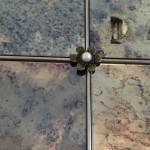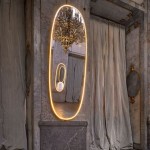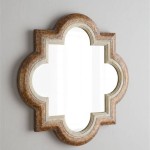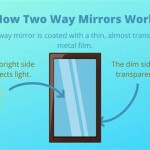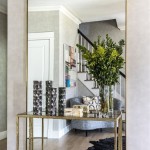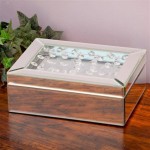Is A Beveled Mirror Better? Understanding the Aesthetics and Functionality
Mirrors are ubiquitous in interior design, serving both functional and aesthetic purposes. They reflect light, create the illusion of space, and contribute to the overall style of a room. Among the various mirror designs available, beveled mirrors stand out due to their distinctive edge. This article will explore the characteristics of beveled mirrors, examine their advantages and disadvantages, and ultimately analyze whether a beveled mirror is inherently "better" than its non-beveled counterparts.
A beveled mirror is defined by its angled, polished edge. This edge is created by grinding down the glass around the perimeter of the mirror, typically at an angle ranging from 0.5 inches to 1.5 inches. The beveling process results in a decorative border that refracts light, creating a subtle, elegant effect. This refractive quality adds depth and dimension to the mirror surface, making it more visually appealing than a mirror with a straight, unfinished edge.
The history of beveled mirrors traces back centuries, finding prominence in Victorian and Art Deco designs. The technique of beveling glass was initially labor-intensive, involving hand-grinding and polishing. This craftsmanship contributed to the perception of beveled mirrors as luxury items. While modern manufacturing techniques have made beveled mirrors more accessible, they still retain a sense of sophistication and timeless appeal.
Aesthetic Advantages of Beveled Mirrors
The primary appeal of beveled mirrors lies in their aesthetic qualities. Several factors contribute to their enhanced visual appeal. One significant aspect is the light refraction along the beveled edge. The angled surface acts as a prism, breaking down light into its spectral components and creating subtle rainbows and highlights. This effect adds a touch of sparkle and visual interest to the mirror, making it more dynamic than a plain surface.
The beveled edge also adds depth and dimension to the mirror. The angled border provides a visual separation between the reflective surface and the surrounding wall, preventing the mirror from appearing flat and two-dimensional. This sense of depth can enhance the perceived size of a room, particularly in smaller spaces. The beveled edge serves as a frame, effectively drawing the eye toward the mirror and making it a focal point of the room.
Furthermore, beveled mirrors complement a wide range of interior design styles. While they are particularly well-suited to traditional and vintage aesthetics, they can also be incorporated into more contemporary designs. The beveling adds a touch of elegance and sophistication that can elevate the overall look of a space, regardless of the specific style. The variety of bevel widths and angles available allows for customization to suit different design preferences.
Functional Considerations of Beveled Mirrors
Beyond aesthetics, beveled mirrors present several functional considerations. While they offer certain advantages, they may also have limitations depending on the intended use. One key consideration is the impact on cleaning and maintenance. The beveled edge, while visually appealing, can accumulate dust and debris more easily than a smooth, flat edge. Regular cleaning is necessary to maintain the sparkle and prevent the edge from appearing dull.
The weight of a beveled mirror is also a factor to consider, especially when mounting it on a wall. The beveling process removes glass, but the overall weight of the mirror can still be significant, particularly for larger sizes. Proper mounting hardware and installation techniques are crucial to ensure the mirror is securely affixed to the wall. It’s important to assess the wall’s load-bearing capacity before installing a heavy beveled mirror.
Another functional aspect is the potential distortion of the reflected image near the beveled edge. The angled surface can slightly distort the reflection, particularly at wider bevel angles. While this distortion is typically subtle, it may be noticeable when using the mirror for close-up tasks such as applying makeup or shaving. For applications requiring precise reflections, a mirror with a minimal bevel or no bevel may be more suitable.
Comparing Beveled and Non-Beveled Mirrors: Cost, Installation, and Suitability
When deciding whether to opt for a beveled mirror, it is helpful to compare them directly against non-beveled mirrors in terms of cost, installation, and suitability for different applications. In general, beveled mirrors tend to be more expensive than their non-beveled counterparts. The beveling process requires specialized equipment and skilled labor, which increases the manufacturing cost. This cost difference can be a significant factor for budget-conscious consumers.
Installation of both beveled and non-beveled mirrors is generally similar, but the weight considerations mentioned earlier can be more pronounced with beveled mirrors. Whether using adhesive, clips, or a hanging system, it is essential to ensure that the mounting method is appropriate for the weight and size of the mirror. Professional installation is often recommended, particularly for large or heavy beveled mirrors, to ensure safety and prevent damage.
The suitability of a beveled or non-beveled mirror largely depends on the intended use and the overall aesthetic of the space. Beveled mirrors are well-suited for decorative applications, such as accent mirrors in living rooms, dining rooms, or hallways. They can also be used in bathrooms to add a touch of elegance, although the potential for increased cleaning requirements should be considered. Non-beveled mirrors are often preferred for functional applications, such as bathroom vanities or dressing rooms, where a clear, undistorted reflection is paramount.
Ultimately, the choice between a beveled and non-beveled mirror is a matter of personal preference and practical considerations. There is no definitive answer as to whether one is inherently "better" than the other. Beveled mirrors offer a distinct aesthetic advantage with their decorative edge and light-refracting properties, while non-beveled mirrors provide a simpler, more functional option. Careful consideration of the factors discussed in this article will help in making an informed decision that aligns with individual needs and design goals.
The market offers diverse styles. From ornate, vintage-inspired beveled mirrors to sleek, modern designs, there are options to suit a wide range of tastes. The size and shape of the mirror also play a crucial role in its overall impact. A large, beveled mirror can serve as a dramatic focal point, while a smaller, non-beveled mirror may be more appropriate for a subtle accent. The surrounding decor and lighting also influence the perceived effect of the mirror, regardless of whether it is beveled or not.
Maintenance implications should be considered, as beveled edges can trap dust and require more frequent cleaning to retain their sparkle. For high-traffic areas or spaces prone to moisture, such as bathrooms, it's important to choose a mirror with a durable, moisture-resistant backing. The quality of the glass and the silvering process also contribute to the longevity and performance of the mirror. High-quality mirrors are less prone to distortion and silvering degradation over time.

Flat Vs Beveled Frameless Mirrors Choosing The Right Style

Framed Vs Frameless Bathroom Mirror Style Guide

Flat Vs Beveled Frameless Mirrors Choosing The Right Style

Frameless Beveled Rectangle Mirror Better Bevel Made In Usa

What Is A Beveled Mirror Okaymirror

Know About Large Beveled Wall Mirrors The Whole Story From A Mirror Authority Mirrorwalla

Better Bevel 24 In W X 30 H Frameless Rectangular Beveled Edge Bathroom Vanity Mirror

What Is A Beveled Mirror Okaymirror

Frameless Beveled Rectangle Mirror Better Bevel Made In Usa

Better Bevel Frameless Rectangle Mirror 24 X 30 Bathroom Wall W Beveled Edge
